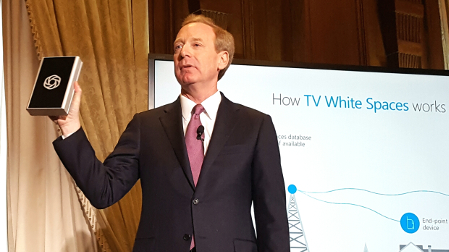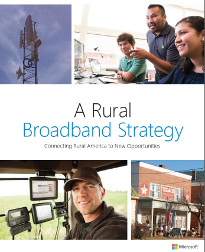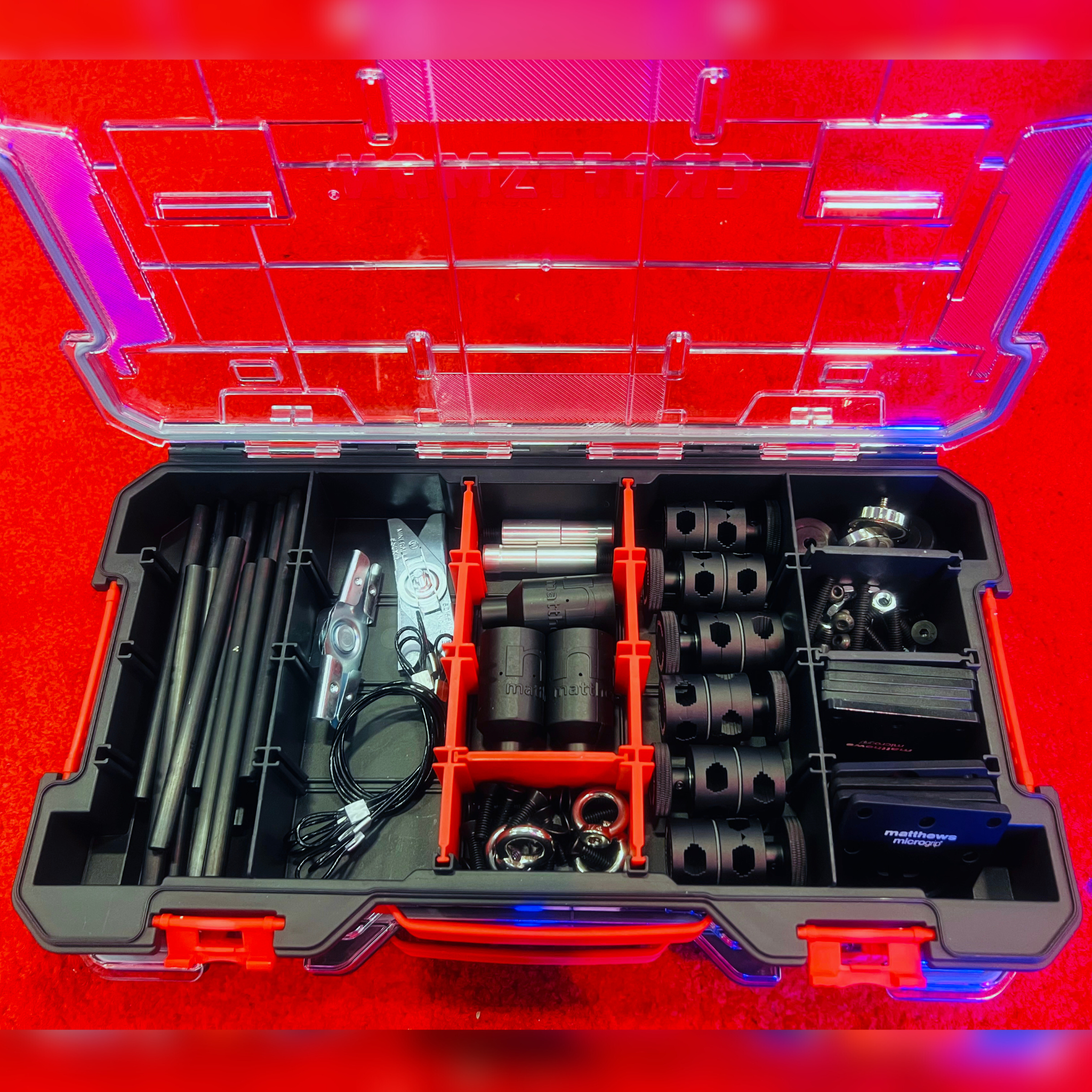Microsoft’s White Space Redux
WASHINGTON—Microsoft delivered a proposal to the FCC to use white space “vacant channels” in the broadcast spectrum range below 900 MHz to create a rural broadband service. Working with other computer industry stalwarts who were “ready to commit substantial resources,” Microsoft vowed to pursue a “White-Fi” system to expand internet access at a low price into areas that traditional wired and wireless Internet Service Providers were ignoring.

In mid-July, Microsoft President Brad Smith updated the TV white spaces proposal to an overflow Washington audience.
That was in 2007.
In the past decade, Microsoft tried several times to establish a two-way inroad into the broadcast spectrum, pushing for the 802.11af WiFi standard that enables wireless Local Area Networks to operate in the TV white spaces (TVWS) spectrum on VHF and UHF bands. The standard, adopted in 2014, has a data rate of nearly 27 Mbps in a six-MHz channel.
But enough about decade-old visions.
‘CLOSE THE RURAL BROADBAND GAP’
In mid-July, Microsoft President Brad Smith updated the TV white spaces proposal to an overflow Washington audience, which included members of Congress, FCC staff and other policy makers. The company’s new “Rural Airband Initiative” envisions a three-channel system that would reach more than 23 million Americans at a cost of less than $12 billion, a fraction of the price of fiber optics or 5G wireless technology, Smith said.
Get the TV Tech Newsletter
The professional video industry's #1 source for news, trends and product and tech information. Sign up below.
The two-way wireless technologies used in the TVWS system would use the same frequencies for both downstream and upstream transmissions, similar to other time division duplex technologies, a Microsoft spokesperson told TV Technology.
Smith set a July 4, 2022, goal for the Microsoft plan to “close the rural broadband gap.”
“The necessary standards are in place” and “innovative business models” are being developed, he said with bold bravura. “This is now ready to scale. It is time for a new company to set a new course.”
The ambitious plan immediately triggered a backlash from broadcasters, low-power TV advocates (who were trying to assess how they figured into the plan) and endorsements from high-tech organizations. Earlier this month, a bipartisan coalition of 43 members of Congress sent a letter to the FCC also supporting the measure.
“We believe that the television white spaces (TVWS) have strong potential to revolutionize broadband internet accessibility in rural areas,” the representatives said in their letter. “TVWS allows a broadband internet connection to cover 9 miles, while navigating the physical terrain that at times can make wireless broadband connectivity difficult. Because of this range, these internet connections are extremely cost-effective requiring minimal infrastructure investments, and are far more dependable than the limited connections that many rural areas currently have.”
The regulatory battleground on which the Microsoft plan will be examined is still unclear, although a Microsoft spokesperson told TV Technology that the company “is already participating in the FCC’s relevant proceedings impacting the availability of TV white spaces and has filed several ex parte letters and other submissions with the FCC.”
In his presentation at the Media Institute monthly luncheon, Smith cited the importance of including low power TV in the plan, pointing out that recent spectrum reallocations have created 210 MHz for broadcasters, 140 MHz for mobile carriers and only 18 MHz for “public” services. He said that federal and government funding “will accelerate this work” to distribute the proposed services.
Smith said that the proposal—running on what he called “underutilized broadcast TV airwaves”—would cost $8–$12 billion nationwide to reach rural areas, which he deemed “more affordable” than fiber optics or Fifth Generation (5G) wireless broadband ventures that could cost up to $50 billion. Smith said that Microsoft will offer a free license for some of its white spaces technology to “stimulate the market,” including community investments.
The proposed system will be able to carry data at speeds up to 400 Mbps, Smith said as he showed prototype receivers now operating at 25 Mbps and 40 Mbps. He said that Microsoft has run about 20 projects worldwide reaching 185,000 users, insisting that “this technology is ready to take off.”
Smith explained that by bundling white space spectrum from several channels, throughput speeds could go even higher, bolstering his push for more bandwidth.
‘THE HEIGHT OF ARROGANCE’
On the day before the public presentation, Smith posted a blog offering some details of the plan, which was then covered in detail in a New York Times story. Those revelations prompted the National Association of Broadcasters to issue a statement several hours before Smith’s speech, denouncing Microsoft’s Rural Airband Initiative as “the height of arrogance.” NAB’s preemptive attack focused on the plan to use broadcast spectrum, although Microsoft “refused to bid on broadcast TV airwaves in the recent FCC incentive auction.”
When TV Technology asked Smith about the NAB invective during a Q&A session after his long but sparsely detailed speech, the Microsoft executive said he did not want to “hurl insults at each other.” He proposed that Microsoft “should sit down with [NAB President/CEO] Gordon Smith” to see how they could “work together” on Microsoft’s vision to bring digital education, telemedicine, agribusiness and other data services to rural America.
“We all have the opportunity to learn from each other,” Smith said.
LPTV: ‘THIS FIGHT IS OUR FIGHT’
The role of LPTV is a major factor, since many rural venues are served by LPTV and translator services.
“The vacant channel order is dead on arrival, simply because it doesn’t work.... It takes channel availability away from low power,” Mike Gravino, director of the LPTV Spectrum Rights Coalition told TV Technology shortly after Microsoft’s announcement. “To get a channel in a larger market, you might have to displace several low powers. This will raise new problems.”
“This fight is our fight,” Gravino said grittily. Describing the Microsoft plan as “fantastic” (as in “fantasy”), he characterized, “everything is fantastic except the enabling mechanism. Our licenses cannot be revoked because we don’t have any place to move.” He said that if the vacant channel order were to happen, that could displace [channels] in the middle of the displacement process... of the repack.”
“We cannot introduce that kind of complexity into the repack,” he added.
By early August, Gravino had laid down his weapons. In a member newsletter blast, the coalition said it was “declaring a truce to end the vacant channel war over LPTV spectrum rights.” Gravino told TV Technology that his intent is “to make love, not war with the tech companies.”
Referring to spectrum, Gravino said, “If they want it and we got it, let’s make a deal.” Although he would not amplify the status of his group’s discussions, Gravino said “the coalition is in active talks with those who want to use spectrum.
By mid-August we’ll be able to announce a plan for a public common for lowband spectrum uses,” he said.
Separately, the Advanced Television Broadcasting Alliance, a coalition of full and low-power TV stations designed to “promote the efficient and effective use of all television broadcast spectrum,” said the Microsoft plan would “destroy” hundreds of LPTV and translator stations, which are not protected in the repack. ABTA said its prime concern is that Microsoft would get access to rural airwaves while ABTA member stations are awaiting their assignments after full-power channels are assigned in the repack. It recommended that the FCC withhold action on the Microsoft plan until the repack and displacement windows for LPTV and translator stations is completed.
ABTA also acknowledged that TVWS and NextGen TV are “excellent partners,” but that there should be time to establish the ATSC 3.0 IP operations before use of vacant channels is authorized.
CHALLENGERS WHO SUPPORT MICROSOFT’S PLAN
Consumer Technology Association President/CEO Gary Shapiro complimented Microsoft for “generously offering” to bring broadband access to rural America, including “training for new jobs and volunteer Microsoft time, patents and expertise.”
“They are suggesting an incredibly cost-efficient way of getting broadband to most of the rural community needing broadband,” Shapiro told TV Technology. “We look forward to understanding any regulatory changes needed to begin deployment of services using TVWS devices and are excited that this promising technology will see more widespread global use.”
Public Knowledge, an advocacy group, also endorsed the proposal. Senior Vice President Harold Feld pointed out that until now “the cost of equipment [for TVWS] has discouraged widespread adoption,” also noting that “resistance from the National Association of Broadcasters has consistently delayed FCC action.”
“Microsoft’s proposal to ‘seed’ TVWS technology guarantees that if the FCC will prioritize rural broadband over broadcast lobbyists, we can solve the digital divide and make affordable broadband available to all Americans,” Feld added. “It’s time for the FCC to put broadcast lobbyists on mute and manage the public airwaves for the benefit of the public.”
FreedomWorks Foundation, which calls itself “an online community of 6.9 million that promotes market-based solutions to public policy issues,” said, in a filing to the FCC proceeding just before the Microsoft announcement, that it supports FCC actions that would “unleash free-market TV white space Internet services.”
THE DETAILS AND PARTNERS
Microsoft characterized its proposal as a blend of “broadband and cloud computing” which would start with 12 TVWS projects in 12 states in the next 12 months (Washington, Arizona, North and South Dakota, Kansas, Texas, Wisconsin, Michigan, George, Virginia, New York and Maine.) Smith said that the first phase could connect up to two million people in rural areas.

He suggested that the initial efforts would trigger “community investments,” vowing that Microsoft will stimulate the market “by licensing our technology,” based on 39 patents, including 14 dealing with white space delivery. He indicated that some of the patents would be licensed at no cost.
“We want to be a catalyst,” he said.
Smith envisioned that white space technology in major urban markets would incentivize equipment makers to enter the business, which would spur expansion into rural areas. He described use of Channel 37, which the FCC has approved for sharing with wireless medical telemetry systems, and pointed to the “vacant channel proceeding” (described in the white paper booklet he distributed) as proving that even more spectrum will be available for the Microsoft proposal.
Current transceiver units are priced under $800; Smith said prices would fall to $200 or less. They will be able to carry data at speeds up to 400 Mbps, he said, with initial models now operating at 25 Mbps and 40 Mbps.
Smith explained that by bundling white space spectrum from several channels, throughput speeds could go even higher, bolstering his push for more bandwidth.
Gary Arlen, a contributor to Broadcasting & Cable, NextTV and TV Tech, is known for his visionary insights into the convergence of media + telecom + content + technology. His perspectives on public/tech policy, marketing and audience measurement have added to the value of his research and analyses of emerging interactive and broadband services. Gary was founder/editor/publisher of Interactivity Report, TeleServices Report and other influential newsletters; he was the long-time “curmudgeon” columnist for Multichannel News as well as a regular contributor to AdMap, Washington Technology and Telecommunications Reports; Gary writes regularly about trends and media/marketing for the Consumer Technology Association's i3 magazine plus several blogs.

